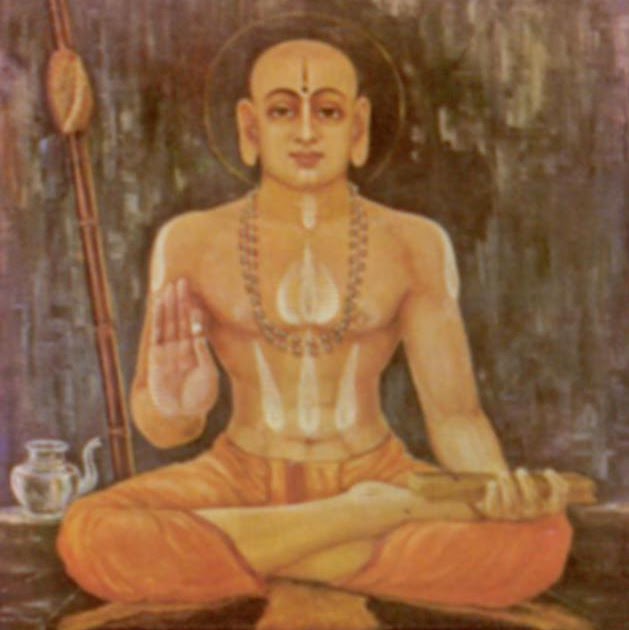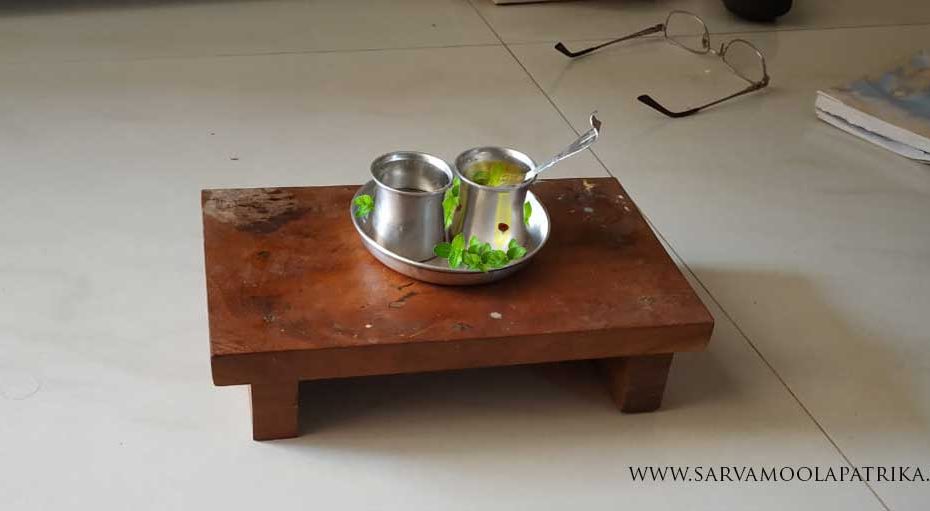- Author: S. Dwarakanath
Everyone who visits a temple is invariably given teertha, the water which becomes holy after it is used to anoint the deity. More often than not, teertha is given thrice and consumed thrice. However, due to various worldly reasons, the three-time norm has been reduced to once, at the most.
The water used in the abhishekam or anointment of a deity is first purified and sanctified by putting it in a separate vessel called the kalasha and the process is known as kalasha sthapana. In any temple where the presiding deity is any of the incarnations of Lord Vishnu, worship of the conch or shankha is mandatory and most significant. After filling the vessel with plain water, some sacred items like turmeric powder, areca nut, paccha karpura or benzoin, saffron, sandal paste, tualsi or holy basil, clove, cardamom are put into the vessel. All the deities in-charge of the seven sacred rivers namely Ganga, Yamuna, Godavari, Saraswati, Narmada, Sindhu and Kaveri are invoked and requested to stay with their respective positive energies in that kalasha. It is believed that Lord Vishnu manifests in the kalasha and Goddess Lakshmi in the conch. Lord Vishnu is always bathed or anointed through the conch amidst the sounding of the holy bell or ghanta. The handle or the upper portion of ghanta always consists of Lord Vayu.
Apart from nirmalya visarjana, gandhodaka or water mixed with pure sandal paste is used in the anointment. This is followed by shuddhOdaka snana or anointment with pure water.
Teertha Pradanam
There are specific mantras prescribed for the priest to recite while distributing the teertha. There is a misunderstanding among most devotees that the holy water or teertha that is sprinkled first into the palm is for cleaning the palms. It is not so. It is called as Shankhodaka Prokshana. Shankhodaka is the water which is used during shankha bhramana done at the end of the puja. It is meant to be sprinkled or worn on the head. The priest should recite the following shloka:
ShanKha maDhyE sThitam tOyam BhrAmitam kEshavOpari|
Angalagnam manuShyANAm BrahmahatyAm vyapOhati||
The water in the pit (middle) of holy conch conceived as to be drawn from the head of Lord Keshava should be worn on the head to get relieved from the worst of sins called brahma hatya.
The norm or the emotion to be inculcated in our minds before consuming the teertha thrice is explained in this stanza:
PraThamam kAyashudDhyarTham dwiteeyam DharmasADhanam|
Truteeyam mOkShasidDhyarthamEvam teerTham triDhA pibEt||
The first consumption or sip is to purify the body; second one is to pursue dharma or spirituality and third one is for attaining moksha or salvation. With this mental attitude, desire and wish, teertha should be consumed thrice.
Alternatively, separate mantras can be recited with each sip:
First one
SAlagrAmashilAvAri pApahAri niShEvaNE|
AjanmakrutapApAnAm prAyashchittam dinE dinE||
Gist: The water that has fallen or flown upon the salagrama cleanses the sins, including those sins accumulated since several past lives, is being consumed every day as a token of repentance.
Second one
AkAla mrutyu maThanam (haraNam) sarvavyADhinivAraNam|
SarvaduhKhOpashamanam ViShNupAdOdakam shivam||
Gist: This teertha will protect me from premature death, all sorts of diseases, all types of grief or distress, as it is the water that has become holy by touching the feet of Lord Vishnu.
Third one
ShareerE jarJhariBhUtE vyADhigrastE kalEvarE|
AuShaDham JAhnaveetOyam vaidyO NArAyaNO Harihi||
Gist: This JAhnavee tOyam or the Ganga waters is the divine medicine bestowed upon humanity by Narayana in the form of the divine doctor and it will erase the carcasses of the precipitated insects or viruses that bear diseases.
Scientifically, the ingredients of teertha, such as sandal paste, cardamom, basil etc., have high medicinal properties. Therefore, they will protect the consumer from all diseases, including epidemics and those inherited.
Norms:
- After sprinkling or wearing the first teertha on the head, which is shanhhabhramana teertha, the first one to be consumed is the one with which Lord Sri Hari is anointed.
- The second one is the water with which Lord Vayu or Mukhyaprana has been anointed.
- The third one is tulasi nirmalya.
- Ensure that not a drop of any teertha falls on the ground.
- Ensure that you do not stand erect while stretching your hand in front of the priest or while consuming the teertha.
- Do not make any sort of sound while consuming the teertha.
- Mantrakshate, flowers, tulasi or basil should be worn on the head.
- Flowers are given to women only.
- Tulasi is given to men of all ages and it has to be tucked into the right ear or at the naval.


Very good information.